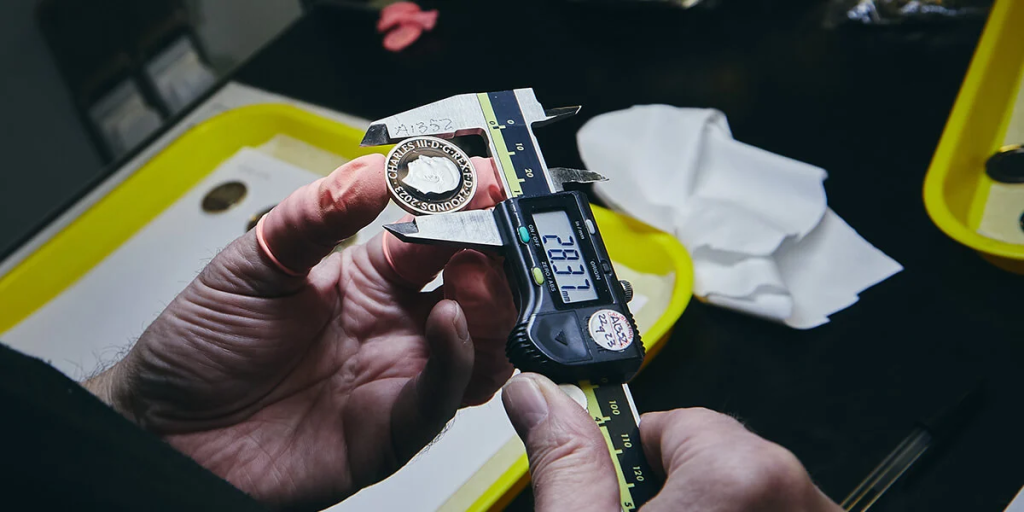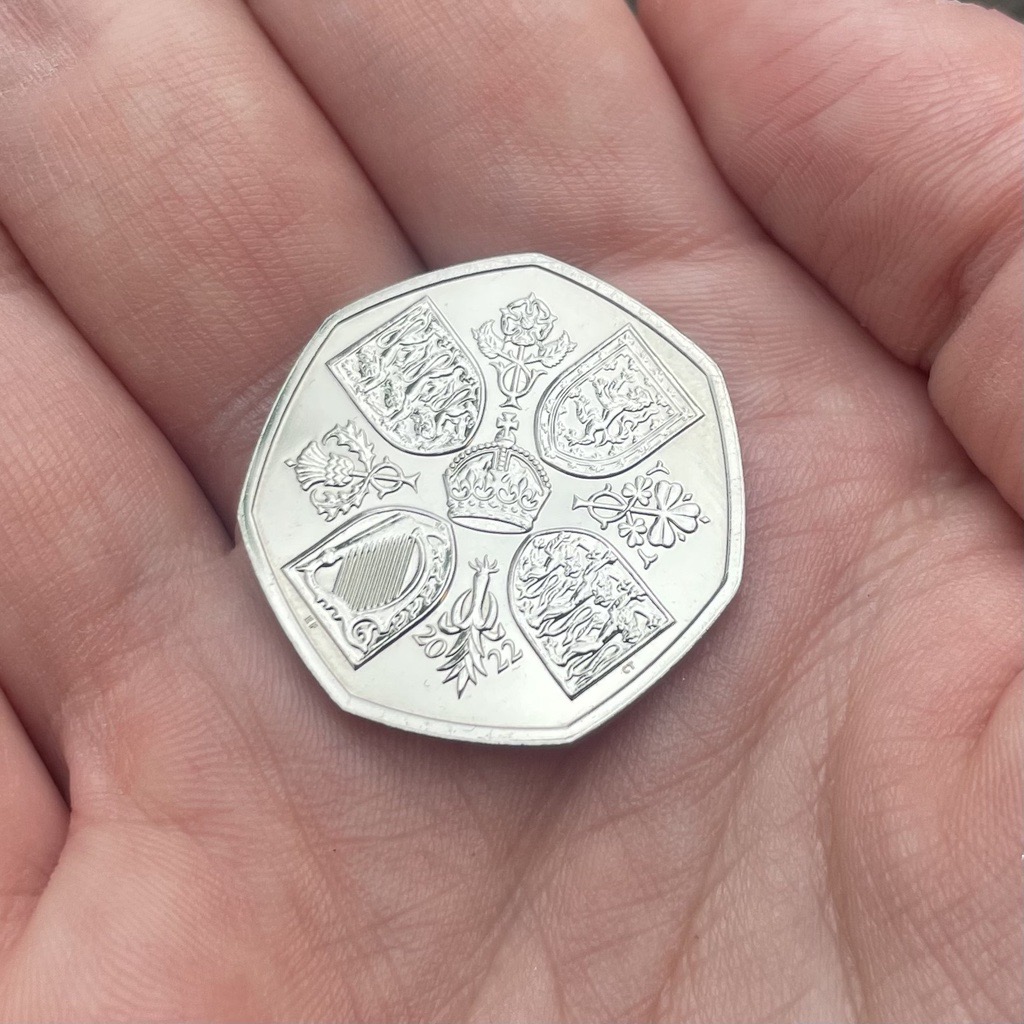Posts Tagged ‘Trial of the Pyx’
One-of-a-kind 50p Trial Piece sells for £1,850!
The Royal Mint held their trial pieces auction on 11th February 2024, and with more than 200 items available, it was their largest to date! The winning bids of the Brilliant Uncirculated 50p pieces varied, but there were some surprising figures – keep reading to find out which piece sold for nearly £1,900!

What is a Trial Piece?
When new coins are being designed, trial pieces are created to allow engineers at the Mint to experiment with different techniques. Some features on coins are ambitious, but by creating trial pieces during the testing process, this helps discover which features may not be viable.
Engineers usually produce between 7 and 30 die trial pieces per product before it is released to the public, depending on how complex the design is. When you consider how many of each coin go on to be created for collectors, these trial pieces are extremely rare and collectible.

Usually, once a product has been tested and approved, most of the die trial pieces are destroyed, with only one of each retained for reference purposes. And, occasionally The Royal Mint holds an auction for these one-of-a-kind trial pieces, giving collectors the chance to get their hands on these unique coins.
If the fact that there is only one of each piece in existence wasn’t enough, each trial piece is also authenticated with a Trial Pieces mark on the obverse. The mark features the inscription ‘ROYAL MINT TRIAL’ around a special high security feature. This mark is easily visible on pieces featuring Queen Elizabeth II on the obverse, however it’s much smaller and harder to spot on pieces with King Charles III’s obverse.

Credit: The Royal Mint Auctions

Credit: The Royal Mint Auctions
Big bids!
In the latest auction, a selection of trial pieces from 2022 and 2023 in various metal specifications were available, but we’ve taken a look at the winning bids on the Brilliant Uncirculated 50ps.

Unsurprisingly, the piece that fetched the most at auction was the 2022 Queen Elizabeth II Memoriam 50p Trial Piece, with a winning bid of £1,850! This was the first UK coin issued following the Queen’s passing, and the first to feature King Charles III on the obverse, making it highly collectable.

Sticking with the royal theme, the 2023 Coronation 50p Trial Piece sold for a whopping £1,100, but it didn’t quite make second place as the 2022 Harry Potter 50p Trial Piece snuck in there with a winning bid of £1,250!


Interestingly, whoever managed to secure the 2022 Harry Potter 50p Trial Piece is now the proud owner of a coin with a lenticular feature on both sides. The Harry Potter 50p series was the first time we’d ever seen a lenticular feature on a UK 50p coin, so to have TWO on the same coin is quite something!

Credit: The Royal Mint Auction
All of these pieces are highly sought after, and even the 2023 The Lion, the Witch and the Wardrobe 50p which sold for the lowest price of all the Brilliant Uncirculated 50ps still fetched 720 times its face value!
Are you one of the lucky ones?
The Trial Pieces auction is open to the general public, so we’d love to know if you have ever been lucky enough to win a bid for one of these special pieces. Or perhaps you’ve previously made a bid but didn’t manage to secure the piece – let us know in the comments below!
How are your coins Quality Assured? The Trial of the Pyx!
As Change Checkers, we love it when new coins are issued. But how are they quality assured? And what processes do they have to go through before ending up in our collections or our pockets?

Since 1282, an independent procedure called the Trial of the Pyx has been responsible for ensuring that newly minted coins (both circulating and commemorative) meet the legal specifications for weight, size and metallic composition. The process takes place annually and can take 2-3 months to complete, but how exactly does it work?

Credit: Matt Brown, CC BY 2.0, via Wikimedia Commons
Phase 1: The Opening
After striking, The Royal Mint randomly selects coins from each batch of denominations to be quality assessed. These coins are sealed in bags of 50 and stored in Pyx chests until the day of the trial.
On the day of the opening ceremony, the Pyx chests are transferred to Goldsmith’s Company Hall in London. The ceremony is presided over by the senior judge in the Court of Justice, the King’s Remembrancer, giving the trial the status of a Court of Law.

Credit: Firebrace, CC BY-SA 4.0, Wikimedia Commons
Did you know? The word Pyx comes from the Latin word ‘Pyxis’, meaning small box.
The trial jury, which is made up of Liverymen and more senior figures of the Goldsmiths’ Company, open each sealed bag of coins and place 1 into a copper bowl for testing by the London Assay Office, the remaining 49 are placed into a wooden bowl to be weighed.
Phase 2: Testing
The coins selected for testing are sent to the Assay Office where they are compared against a Trial plate. These metal plates, made of gold, silver, platinum, nickel and zinc, are held at the National Measurement and Regulation Office. The oldest surviving Trial plate, from 1477, resides in The Royal Mint Museum.

Credit: The Royal Mint
Next, the base metal and precious metal coins are separated, with the base metal ones going through X-Ray fluorescence spectrometry, and the precious metal ones sent for laboratory chemical testing. The main purpose of these tests is to break down the coins’ composition to check their metal content meets specifications.
Phase 3: Verdict
After rigorous testing, the Assay Office decide if the coins meet all specifications set out in the Coinage Act or by Royal Proclamation. Their recommendations are passed to the Senior Master and the King’s Remembrancer, who instruct the Goldsmiths’ Company.

Credit: The Goldsmiths’ Company
The final verdict is delivered to the Chancellor of the Exchequer or their deputy and the Deputy Master of The Royal Mint.
The oldest judicial procedure in the country
The Trial of the Pyx dates back as far as the 12th century, making it one of the oldest judicial procedures in the country. As such, should the coinage be found to be substandard, the punishment for the Master of the Mint would be a fine, removal from office or even imprisonment!
Luckily however, modern coin production processes have become far more reliable, therefore the last Master of the Mint to be punished was Sir Isaac Newton in 1696. Newton was, of course, celebrated on the Sir Isaac Newton 50p in 2017, a coin that quickly become popular with collectors. Find out what makes this coin so interesting >>
Did you know about this process? Or perhaps you’ve been lucky enough to attend the trial as a spectator? Let us know in the comments below!
Freedom in the palm of your hand
Exchequer Secretary, Robert Jenrick has seemingly secured the future of Britain’s Penny and Tuppence coins.

Speaking at the historic Trial of the Pyx ceremony on the 27th april, the Treasury Minister launched an impassioned defense of coins.
Describing coins as “freedom in the palm of your hands” he went on to focus on their crucial role in uniting a nation, as well providing simple and easy payment method for over 2.7m Britons.
But most importantly, for those of us fearing the demise of the British Penny and Tuppence, hinted at by Chancellor Philip Hammond during his Spring Statement, he was very clear.
“So the penny is safe. Safe today, safe as long as the British public cherish it and see in it, more than a unit of currency, but a metaphor for the enduring strength and continuity.”

